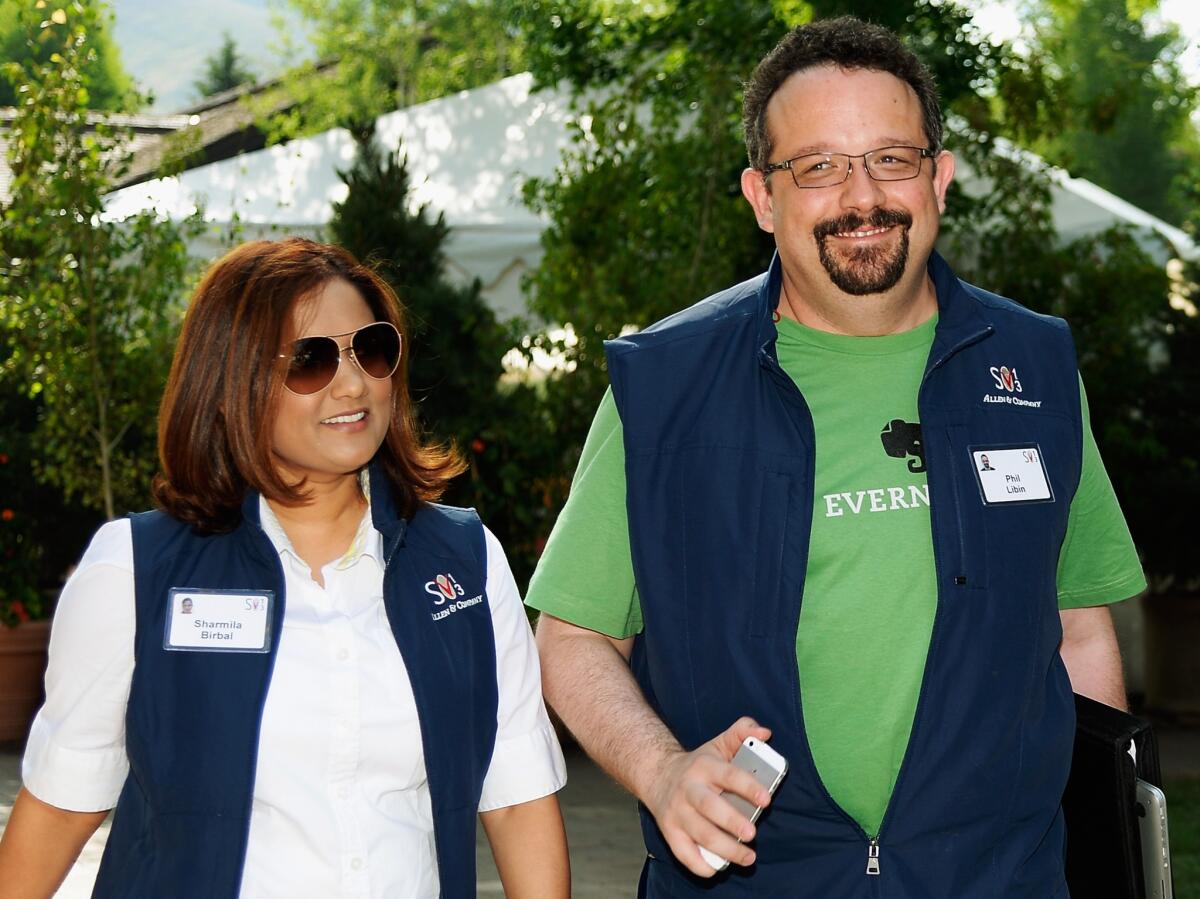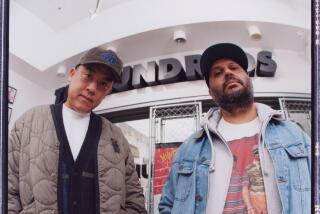Evernote CEO Phil Libin wages war against ‘stupid office signs’

- Share via
Over the weekend, I wrote a “How I Made It” feature on Phil Libin, chief executive of Evernote. As the story notes, Evernote is growing like crazy, has moved into a new headquarters and is celebrating the fifth anniversary of its first app.
Libin comes across as a pretty transparent guy, and he’s never dull. And he had a lot to say about how he was handling his role as leader of the company as it grows beyond its start-up roots.
So for those of you who are hankering for more, I’m posting the extended edition of our conversation here.
PHOTOS: The 10 biggest tech gadget fails
Home, sweet home: On Evernote’s new headquarters: “This was a Wells Fargo building. It was a cube-farm hell before we moved here. So we had to tear everything down to open it up a lot. It’s nice to have a space we got to design and think through.”
Size doesn’t matter. Or does it?: Evernote is “at a size where I don’t know everyone anymore. Which is kind of disconcerting. I’m just now still making peace with the question of how do I live in a company where I don’t know every single person. You have to make sure communication stays good.
“When you’re a small company and you’re all sitting in the same room, you don’t realize the benefits of that. You don’t realize just how much you’re getting for free. Everyone knows what everyone is doing. You get good communication. You get quick decision making. As you grow in size, most companies assume you lose that start-up culture inevitably. But it’s not that you lose it. It’s that you explicitly have to pay for it. You have to explicitly put in the effort not to lose those benefits. It is not inevitable that you cease to be a start-up. But if you don’t do anything, you will.”
How to stick it to the man when you are the man: “There are the encroaching forces of corporate bureaucracy that have to be actively beaten back. But it is possible to do it. You have to be very intentional about it. I’ve done a bunch of things over the past year in that vein. And I’m sure more will come.”
Signs, signs everywhere: “I declared war a few months ago on stupid office signs. I realized that I started seeing signs around the office everywhere. Like, ‘Your mother doesn’t work here, make sure you wash the dishes after yourself.’ And the signs suck. They’re passive aggressive. They’re kind of snotty. And I thought this was really bothering me. On the refrigerator, someone put up a sign that said, ‘Bottled water is for guests only.’ And I was like, ‘What the hell?’ What they were trying to say is, ‘Hey, employees, we got you all really nice water bottles and it would be nicer for the environment if you used them.’
“So I wound up for a couple of months going around and ripping down all the signs that weren’t in the right tone, and that weren’t really expressing themselves. And going and yelling at people who put them up. And it’s worked. It’s been six months since I’ve seen a poorly written, passive aggressive sign. I think it really does have an impact. Because when you get to be a company of a bigger size, it really does start to feel like work when you see the accumulation of crappy culture like this.”
Mirror, mirror: “When you look at any product, and kind of squint at it, you can see the reflection of the company that made it. You can see what the office looks like and how it’s organized and see whether they’re in cubes or not. Every product is a reflection of the company and its culture and physical space. I don’t think you can hide it. The only solution to making beautiful products is to have that reflection be accurate. Have a beautiful company so its reflection looks good.
“So the same people who think about product design think about office space design. The facilities team reports to the guy who is our senior-most designer. And that was an intentional decision to say these are the same things. The physical space is part of the product. And the way we set up the space reflects the way we think about the product and whether it’s open and pleasant and efficient. An office space that has inefficient communication will not create a product that enables efficient communication.”
Mistakes were made: “When we moved here we thought, ‘Man, this is a great location for signage. We should put up a big sign.’ And we weren’t going to go to a sign company and say, ‘Make us a sign.’ We didn’t want to look like a mall fabric store. We wanted something distinctive. We have great designers, so let’s design a sign. And it’s just beautiful. It wraps around the building. I’m really happy with it.
“The problem is that our designer before that had only designed icons and software. That sign turned out to be eight times heavier than the building could support. We just didn’t think about it. It turns out when you design the sign, you’re supposed to think about the weight. Now we know. So we had to get structural reinforcement for the roof to support the sign. That took nine months. The upside is we got to make our own sign. The downside is it really stretched our budget. But now the designers also feel they can make just about anything. It’s a healthy design attitude.”
Do the right IPO thing: “We want to make a 100-year company. Being public is not a goal, but it’s a step. A lot of companies hurt themselves in that step. They sort of run toward it and trip over it. We don’t want to be public in the sense that it in and of itself is a goal. We just think that if we’re going to be around for 100 years, it’s morally correct to be a public company. It’s morally correct to be more transparent and to let people be owners if they want to be owners. So we’ll walk up to it slowly. No earlier than 2015 or 2016.”
Evernote is an app that...: “I think the thing we have the most trouble with is getting people to understand and to know about the breadth of the things we do. But that’s our problem. It’s not like people have the wrong idea. It’s that we suck at communicating the right idea. That is something we have to constantly strive at and improve. And I think we’ve gotten better at it the last couple of years. But there is definitely a lot more to do.
“What winds up happening at Evernote conferences is that people go and they say, ‘Oh, I love Evernote and I’ve been using it for years and now I realize I’ve only been using it for 5% of what it can do.’ And the problem is that it’s a different 5% for everyone. If everyone just found the same 5%, then we’d just cut the other 95% and save ourselves a lot of money. It’s a very broad usage base. And we need to be a lot better about tying it together. And I think we have. We’ve got a few things we’re launching over the next few months to help with that.”
Competition: “I think our top competitors are our best partners. The five big companies that we do the most work with are Apple, Google, Microsoft, Facebook and Amazon. All of those guys have something that competes with us. But it doesn’t matter. Evernote is my third company. And I’ve worked for 10 companies in my life. And at each of those companies, we always had an arch nemesis that we would foucs on. And we’d have to crush that guy. And 10 times out of 10, it never mattered.
“Who we thought was the competition never had a big impact on the success or failure of the company. It was always something else. It was some other factor or some company we had never thought of. So we said at Evernote that we don’t know who our competition is. The only way we can succeed is if we make a great product. And the only competitive threat to us is somebody who makes a better product that makes Evernote seem stupid. The only defense for that is that we have to be the people who make a product that makes the last version of Evernote look stupid.”
When something wrong feels so right: “I never really thought about having a career. And I never really thought of myself as an entrepreneur. I’ve never been motivated by starting companies. And until recently, my path in life has always felt like failing. I’ve always felt like the right thing to do was have a long-term job as a doctor, a lawyer or an engineer, and that wasn’t quite working out. I dropped out of college when I had four credits left because I got into some fight with the administration. So my life has always felt like I was falling off the branches of where you’re supposed to be. And through that whole time, I was always doing stuff on my own and I was making money. So I had this weird conflict where I said, ‘I’m not accomplishing the things that I always felt were expected of me. And yet I’m living pretty well.’ But it wasn’t until I was in my 30s that this stopped feeling like failure to me. I guess this branch I’m on is an acceptable way to lead your life.”
Advice to future entrepreneurs: “The thing that really made a difference to me at Evernote, and the thing I would say to people, is doing stuff for yourself. The first two companies we made for other people. Because we followed the conventional wisdom that said you should ask, ‘What does the market want? What do your customers want?’ It doesn’t matter what you want. That was actually good advice 10 years ago. But it’s terrible advice today. I think right now you should build something for you, something you think is great, something you think is beautiful, something you want to use. It’s a much happier way to live.
“But what has also changed, with app stores, is that if you make something for you, that you love, there are people out there who will love it and they’ll be able to get it. And that was never the case before. If you want to make something in consumer technology, the last thing you should be doing is figuring out what the market wants. You should make something magical.”
ALSO:
Google to offer way to find lost or stolen Android devices
Apple says free iCloud storage to end for former MobileMe users
Techies don’t love Moto X; also, company drops sexually charged ads







